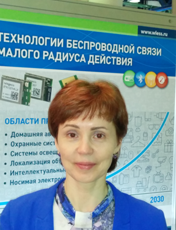Krivchenko Tatiana

Tatiana I. Krivchenko. I was born on June 30, 1963 in Leningrad.
I was graduated from school N95 of Leningrad in 1980 and entered the State Polytechnic Institute named after Mikhail I Kalinin, department “Information and measuring equipment”. I graduated this course with honors in 1985 and started to work as an engineer in this department.
In 1992 I became a post-graduate student and in 1995 defended PhD thesis dedicated to integrating ADC improvements for measuring devices.
In 1996 I began working as an assistant at the Department of “Power stations” of the State Polytechnic Institute. In 1999 I was promoted to the position of assistant professor.
In 2000 I began to work as a leading specialist of EFO Ltd. with responsibility for technical support of Motorola, Freescale, Atmel, Cypress microcontrollers and Motorola GPS-receivers. In 2005 I was promoted to a position of the head of EFO wireless solutions department. Currently I am working at this position.
Reports:
Advances in wireless communications allow today to use new technologies not only for wireless data transmission, but also for wireless ranging. Measurement of the relative distance between two points is the basis for localization systems inside buildings, covered parking lots, mines where satellite navigation systems are not available. Local positioning could be used in a wide range of security systems, collision avoidance systems on the factories and transport and in various automation systems to improve the efficiency of production processes.
Following parameters of the wireless signal could be measured in order to calculate the distance between two points: received signal strength indication (RSSI), signal propagation time and phase incursion.
RSSI method can be implemented with the most standard inexpensive wireless transmitters. However analysis of the existing systems shows that this method is the least accurate and the least protected from attacks. Way to improve the accuracy of RSSI systems is time-consuming pre-calibration of the system on each particular object.
Method of measuring distances by phase is interesting because it provides accuracy of 1 m or even less with inexpensive 2.4 GHz and 868 MHz transceivers. This method is well suited for location of slowly moving objects.
The accuracy of the methods based on the measuring RF signal propagation time depends on the signal bandwidth. It is known transceivers that can measures distance with error from some centimeters up to some meters and are intended for different types of applications.
Besides the positioning accuracy for localization systems where absolute coordinates are defined following characteristics are important: time of the absolute coordinates determining, the maximum possible number of mobile tags, throughput of the system. The report provides an analysis of these parameters by the example of the fixed localization system of company Nanotron.
Finally, the report provides an analysis of compliance of various wireless localization technologies to radiofrequency regulation requirements established in Russia.





